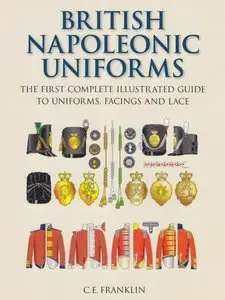British Napoleonic Uniforms: The First Complete Illustrated Guide to Uniforms, Facings and Lace By C.E. Franklin
Publisher: The History Press 2009 | 336 Pages | ISBN: 1862274843 | PDF | 220 MB
Publisher: The History Press 2009 | 336 Pages | ISBN: 1862274843 | PDF | 220 MB
This book illustrates and identifies the different uniforms of the numbered regiments of cavalry and infantry within the British Army during the Napoleonic Wars. Named but unnumbered regiments, foreign regiments in British pay, regiments especially recruited for service in the colonies or the veteran and Garrison battalions have not been included. The first phase of the Napoleonic Wars began in February 1793 and continued until the Peace of Amiens in March 1802. The second phase started in May 1803, and continued until after June 1815 when Napoleon abdicated. At the beginning of the conflict the British uniforms were beginning a process of change. The shortcomings of the long coats had become self-evident and the war provided the stimulation to provide a progressive replacement of the unsatisfactory items. The exact nature of the dress of a unit at any one time is difficult to resolve as there were no official dress regulations published before 1833, just a random series of Orders and individual regulations published by Horse Guards, most of which are recorded in the papers of the National Archive. There are the contemporary illustrations of the period and those known extant examples have been consulted during the preparation of this study. It may be that other regulations and items exist in private hands, but those in the public domain have been considered. In some of the regimental illustrations hat plates, breast plates and buttons have been included; these are selected examples to give a feel for the type and style and do not attempt to record the changes in pattern for any particular regiment throughout the period. In every case, the reader should remember that uniformity was an ideal rather than a fact, and it must also be remembered that it was the practice of officers to adopt whatever variations of dress they considered appropriate. It is quite clear that whatever the regulations prescribed, the personnel were often dressed in a manner contrary to the current regulations. In many cases the significant factors were a combination of regimental practice, the size of the purse, being dressed a la mode, and often simply what was available. Provision of the uniforms for the other ranks was the responsibility of the colonel of the regiment. They arranged for manufacture and supply according to the laid down pattern or their whim, on repayment from the treasury, and so regimental variations were common. Officers purchased their own uniforms, usually following the practice and tradition of the regiment rather than regulations. The history of dress for any regiment invariably relies upon many influences, not least the decisions of the colonel. In many cases, the apparent absence of any surviving clothing or records has meant many of the previous studies have been limited. This book draws together contemporary information to provide a new insight into the uniforms and regimental identification of the different regiments of the period; while some of the material has been considered before, much is placed into the public domain for the first time.



